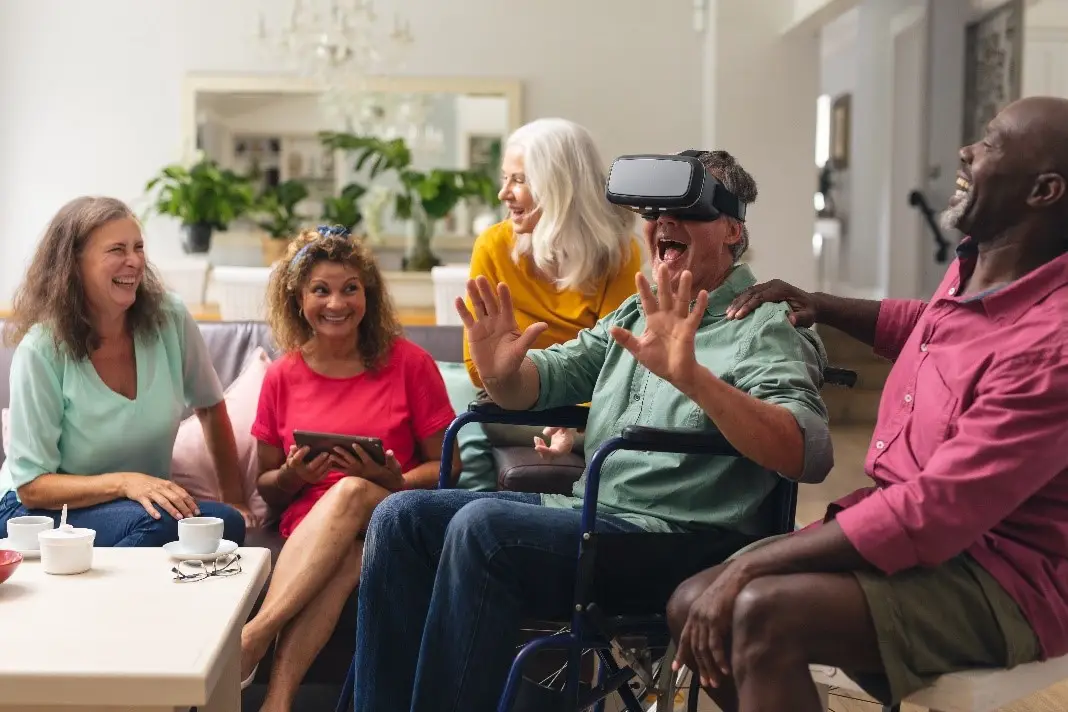Every year, an increasing number of Americans reach the point in their lives where their age and health results in them being no longer able to live independently. But not all seniors have the same needs when it comes to requiring assistance. While some may only need minimal help with their usual daily activities, others will require more substantial care and support.
Determining the right level of senior care for yourself or your loved one can be a daunting experience. And learning the senior care lingo can be a lot like learning a whole new language while you are trying to put out a fire. Making matters worse is that decisions often need to be made quickly, often within a few days.
This guide is designed to help take some of the guesswork out of your experience. In it, you will find outlines of the most common types of senior care available and their differences, so you can make a more informed decision for yourself or a family member facing what may be a difficult time of life.
Types of Senior Care Facilities
There are four primary types of senior care facilities/communities in the United States, with each offering seniors specialized services designed to meet their unique needs. These facilities or communities are:
- Independent Senior Living
- Assisted Living
- Memory Care
- Skilled Nursing Care
In addition to the above four primary types, there are additional senior care options that are available for consideration in cases where an alternative level of support may be preferred. These include:
- In-Home Care
- Respite Care
- Senior Day Care
Independent Senior Living

Independent senior living communities are designed to provide adults, generally age 55 and older, with a living environment where they can reside among others their age. These communities are for seniors who do not yet need assistance with activities of daily living (ADLs), but who are looking for a place to live where they can enjoy additional types of support, onsite amenities, socializing opportunities, and other activities.
Independent senior living communities can also be known by different names, including:
- Retirement Communities
- Retirement Homes
- Congregate Care
- Retirement Villages
- 55 + Communities
- Senior Apartments
These communities offer a wide range of features and services that are designed for active retirees who are still able to live mostly independent lives. Some of the features and services commonly provided in these communities can include:
- Private accommodations
- Transportation services
- Community centers
- Fitness options, such as gyms, exercise classes, swimming pools, golf courses, and tennis courts
- Onsite salons
- Onsite libraries
- Dining halls and other meal services
- Group activities
The actual cost of living in an one of these communities varies by the location and services provided. In the U.S. independent senior living communities typically cost between $1,500 to $4,000 per month. Many communities also charge their residents a monthly fee, similar to a homeowner's association fee, which helps cover the community's maintenance and amenities. Medicare does not cover any costs associated with independent senior living.
If you or your loved one is active and requires minimal assistance in completing daily tasks, then an independent senior living community may be an appropriate senior care option.
Assisted Living

Assisted living facilities are designed for seniors who want to live independently but require some degree of help with their daily care. These communities offer a comfortable residential environment, not unlike independent senior living communities, but with more personalized levels of care and support.
An assisted living facility may also be referred to as:
- Assisted Care Community
- Senior Cottage Living
- Assisted Group Care
- Senior Care Facility
- Residential Care Homes
- Senior Group Homes
- Personal Care Home
- Adult Family Homes
- Board and Care Homes
Upon admission into assisted living, every senior undergoes a health assessment by the community according to state regulations. This is done so that an individualized plan of action can be created for them.
Assisted living provides a wider range of features and services than independent senior living because residents often have specialized care requirements. Some of the most common features and services offered at these facilities include, but are not limited to:
- Private or semi-private accommodations
- Medication management
- Transportation services
- Assistance with ADLs, such as help using the bathroom, doing laundry, getting in and out of bed, getting dressed, and grooming
- Housekeeping services
- Diet-specific meals
- Social programs, recreation services, and group activities
- 24/7 support staff availability
Unlike those who choose to move into an independent senior living community, seniors who move into assisted living facilities often face emotional obstacles because doing so is acknowledging that their days of living independently are over. This can make it difficult for some seniors to accept their new living environment. As a result, many assisted living communities encourage their new residents to bring their furniture and other personal items with them to help make their new living space feel more like home.
Assisted living costs also vary by location and services and amenities provided, but in most cases, it is more affordable than home health services and nursing care in the same area. In the U.S. assisted living communities typically cost between $3,000 to $8,000 per month.
While Medicare does not typically pay for assisted living, many states offer home and community-based waivers that are designed to help low-income seniors afford assisted living. Medicaid may provide some degree of financial help in many states, so you should check with your state Medicaid resource to find out what type of financial assistance might be available. Many long-term care insurance plans can also pay for some portion of care.
If you or your loved one has reached the point where independent living is not an option, then assisted living can be a logical next step.
Memory Care

A memory care facility provides long-term care specifically for seniors living with Alzheimer's disease or another form of progressive-degenerative dementia. Seniors in memory care require a higher level of support than what is offered in assisted living, mostly because their dementia has progressed to the point that it is no longer safe for them to remain at home. But in most cases, they are generally free of any other major health concerns that might require even more intensive care.
This type of senior care facility can also be referred to as:
- Alzheimer's Care
- Dementia Care
- Sundowners Care
Memory care facilities provide seniors who have been diagnosed with Alzheimer's or dementia a safe and structured environment with specialized services that are designed to help protect them against wandering and self-harm. Some of the common features and services offered at the typical memory care facility include:
- Semi-private or private accommodations
- Transportation services
- Medication management
- Variety of meal options
- Housekeeping services
- Personal laundry and linen services
- Social and recreational activities
- In-home medical alert systems
- Some assistance with ADLs, including dressing, grooming, and getting in and out of bed
- Group and individual therapeutic recreational programming to help slow the progression of memory loss
- 24/7 security and enhanced security features
- 24/7 staff specially trained in memory care support
- Anti-wandering systems
- Appropriately low staff-to-resident ratio
- Family support groups
- On-site physical, occupational, and speech-language therapy
- On-site physician's services
- Limited skilled nursing care
The cost of memory care depends on several different factors, including location, floor plan, and how much care and support is needed. Because of the specific nature of care and services being provided in these facilities, their costs will be higher than an assisted living facilities in the same area. In the U.S. memory care facilities typically cost between $4,000 to $10,000 per month.
While nearly all adults with dementia are entitled to receive Medicare benefits, it is important to note that Medicare does not pay for long-term care – aside from 100 days of skilled services or rehabilitative care for a qualified stay. It will, however, pay for most medical needs related to dementia. Medicaid can help cover some memory care costs for low-income seniors and certain state or community-based waivers may also be available.
In terms of coverage by group employee health plans, retiree medical coverage, Medigap insurance, long-term care insurance, and disability insurance, coverage must be in place prior to a senior being diagnosed with Alzheimer's or dementia as these resources tend to have strict pre-existing condition clauses. Other avenues for financial help can be accessed through grants from the Alzheimer's Foundation of America (AFA), the Alzheimer's Association (AA), and the National Family Caregiver Support Program (NFCSP).
If your loved one has been diagnosed with Alzheimer's disease, progressive dementia, or another cognitive impairment, then a senior living facility with memory care services may be the safest and best place for them to be.
Skilled Nursing Care

Skilled nursing care is designed to provide seniors who are unable to care for themselves with high-level care and support, 24/7 monitoring, and medical assistance for certain chronic conditions, infections, or short-term rehabilitation from an illness, injury, surgery, or stroke. Skilled nursing can be provided in either short-term or long-term models, but when the long term care is necessary, admission into a nursing home, or long-term skilled nursing facility, is required.
Short-term skilled nursing is designed to provide care for seniors who are in need of acute care or are recovering from a medical procedure or accident. It features full-time medical staff at the facility. Most seniors in short-term skilled nursing require aid in bathing, dressing, eating, and getting in and out of bed. As a result, there is a limit on the length of time that short-term skilled nursing facilities will keep patients. Most facilities will cap the time spent at 100 days, which is the maximum number of days that Medicare will pay for.
A long-term skilled nursing facility is a licensed residential facility that provides its residents with on-site continuous skilled care that is more intensive than what a short-term facility can provide. These facilities also have skilled nursing staff, including RNs, LPNs, and certified nurse aides, who are available 24/7, and their tasks include a broad range of responsibilities, such as administering medications and injections, monitoring medical equipment, wound care, and physical therapy. This level of care is reserved for those patients that cannot care for themselves and are not expected to recover quickly, if at all.
Both short-term and long-term skilled nursing care can also be known by other terms, including:
- Skilled Facility
- Nursing Facility
- Nursing Home
- Skilled Care
- Convalescent Home
- Skilled Therapy
Like the previous senior care facilities, skilled nursing facilities also provide a number of features and services that are designed to help improve their residents' quality of life. Some of the most common features and services include, but are not limited to:
- Private or semi-private rooms
- 24-hour supervision
- IV therapy
- Respiratory therapy
- Physical therapy
- Occupational therapy
- Speech therapy
- Pain management
- Nutrition planning and meal preparation
- Housekeeping and laundry services
- Social programs and activities
- Assistance with ADLs
When a senior enters a skilled nursing facility, they undergo an initial health assessment as well as ongoing health assessments to evaluate their physical and mental health, medications, and their ability to handle activities of daily living, such as bathing and getting dressed. This allows the staff to create a personalized curriculum of care to help ensure that the resident receives the appropriate level of care for them to enjoy the highest quality of life.
Costs for skilled nursing can vary greatly depending on location, the length of stay, size of the room, care requirements, and other factors. Their costs tend to be among the most expensive of all the available senior care solutions. In the U.S. skilled nursing facilities typically cost between $8,000 to $10,000 per month.
If a senior meets Medicare's requirements and the facility is Medicare-certified, it will generally cover stays of up to 100 days. In most cases, the facility and Medicare use specific assessments to determine whether Medicare will pay for the senior's stay, or if the resident will be responsible for some or all of their costs. If a senior requires additional care and Medicare pays for the bulk of the first 100 days, then once 100 days have passed, the senior will be responsible for all their ongoing costs. However, some or all may be covered by their private long-term care insurance or Medicaid, for those who have that coverage and are eligible.
Care Levels Compared
As stated earlier, each of these senior care solutions are designed for a certain type of senior with certain types of needs. Here's a quick breakdown of their primary differences.
- Independence Levels: Of the four senior care solutions, only independent living facilities require their residents to be fully self-sufficient. Assisted living, memory care, and skilled nursing facilities each require their residents to need some degree of assistance performing their activities of daily living.
- Care Services: Independent living communities provide little to no care services, as their residents are active and relatively healthy. Assisted living facilities provide assistance with ADLs and care for minor or temporary health conditions. Memory care facilities are designed to provide quality care specifically to seniors who have Alzheimer's, dementia, or other cognitive impairments, but no other major health issues. Skilled nursing facilities provide short- and long-term care for a wide range of chronic health conditions that aren't capable of being supported in assisted living.
- Staffing and Qualifications: The support staff at independent living communities typically aren't required to receive any special training other than in hospitality or have a degree in senior-specific fitness, as no medical support is provided in these communities. In assisted living, the support staff is required to meet their state's licensing and certification requirements for assisted living communities and their doctors and registered nurses must be board-certified. The staff at memory care facilities need to receive adequate initial training for dementia care and undergo ongoing competency exams and continuing education to help ensure the highest quality of care. In skilled nursing, the staff consists of licensed nurses, physical and occupational therapists, speech pathologists, and audiologists.
- Amenities and Facilities: All the senior care solutions mentioned here provide a range of amenities and facilities that are designed to help maximize their residents' quality of life, and in many cases, what is available can be very similar across the four. However, each facility and community is unique in what it offers its residents, so if there is something specific you are interested in, it is recommended to ask the facility.
Choosing the Right Level of Care
Because of the varying degree of the services provided, choosing the right level of senior care is essential for ensuring that you or your loved one receives the appropriate care and support that's required. Thus, before you make your decision, you should review the factors that will impact it. These factors include:
- Health condition
- Mobility
- Cognitive abilities
- Amount of family involvement
- Community preferences
You should also consult with your or your loved one's physicians and medical professionals and consider their recommendations. There are also tools such the Senioridy Care Level Calculator which can be helpful in choosing a type of facility
Additional Senior Care Options
Aside from the standard levels of institutional care there are also other options that might be worth considering, including in-home care, respite care, and senior day care.
In-Home Care

In-home care is the only non-facility option, so all care and support services would be provided to a senior who is still living at their residence by a professional home care company. This type of service may also be known as:
- In-Home Personal Care
- Home Health Care
- Home Care Aide
- Home Health Workers
- Home Nursing Care
- Home Therapy
With In-Home care, an employee from the home care company assists a senior with their ADLs, like meal preparation, bathing and dressing, and more, as well as their IADLs (Instrumental Activities of Daily Living), like bill payment, transportation, getting to appointments, or just providing companionship.
There are two types of care levels available with In-Home care, Basic Care and Nursing Care. The primary difference between the two is that basic care's workers do not have medical training whereas nursing care's workers are medically trained do a degree. They can provide additional medical care support services, such as wound care or help with medications.
It should also be noted that In-Home care can also be combined with Independent Living, and, in some cases, with Assisted Living in order to achieve a balance between independence and care.
The typical In-Home care service charges its client an hourly rate, usually between $20 per hour and $30 per hour, and most will require a minimum number of hours on either a daily or weekly basis. These services are usually paid for via private pay options, but in some cases Medicaid or Medicare may offer some payment assistance. Some long-term health insurance programs may also provide some degree of coverage.
Respite Care
Respite Care is a planned temporary care service that is designed to provide some relief to a senior's caregivers. Many nursing homes and assisted living communities include Respite Care at their facilities, and these services can last from a few short days to a few months.
Respite Care can be a great way for a senior to get used to a new community or to see if the community is a good fit for the senior. Many families choose to move a senior member into Respite Care to provide them with some social stimulation and companionship.
Respite Care can also be referred to as:
- Short Term Senior Care
- Caregiver Respite
Respite Care costs can range anywhere from $25 per hour to $35 per hour. Typically, seniors will need to pay for this service via private pay, although some state Medicaid services may offer programs that can help low-income seniors afford the care they need.
Senior Day Care

Senior Day Care facilities provide a broad range of amenities. Some are self-hosted and are housed in facilities that are only open during the daytime hours. Some Senior Day Care centers are actually offered at Senior Living Facilities and are daily programs that are extended to those who are not residents of the community.
Senior Day Care is also commonly known as Adult Day Care. This type of senior facility typically offers access to a variety of activities and services from morning until evening and generally provides seniors with two or three meals a day. Daily programs often consist of educational opportunities, exercise classes for those that can participate, entertainment, and the opportunity for social stimulation and companionship.
Senior Day Care costs between $75 to $50 per day depending on locations and services provided. Seniors are responsible for paying out-of-pocket for their usage of these facilities.
A Summary of Factors that Affect the Cost of Senior Living
- Location: The cost of senior living varies widely depending on the state and city where you live. For example, senior living facilities in major metropolitan areas are typically more expensive than those in rural areas.
- Type of facility: The type of senior living facility you choose will also affect the cost. For example, skilled nursing facilities are the most expensive, followed by memory care facilities, assisted living facilities, and independent senior living.
- Level of care: The level of care you need will also affect the cost. For example, if you need a lot of help with activities of daily living (ADLs) and medical care, you will pay more than if you need less help.
- Size of room: The size and type of room you choose will also affect the cost. For example, a private room will be more expensive than a shared room.
- Amenities: The amenities offered by the facility will also affect the cost. For example, facilities with amenities such as a pool, fitness center, and restaurant will be more expensive than those without these amenities.
Tips for Saving Money on Senior Living
- Shop around and compare prices from different facilities.
- Consider moving to a less expensive area.
- Choose a smaller room or a shared room.
- Ask about discounts for veterans, seniors, or low-income individuals.
- Apply for financial assistance programs.
Conclusion
The prospect of becoming disabled and needing long-term services and supports (LTSS) is one of the most significant risks facing older Americans today. So that you or your loved ones can get the most appropriate care for their particular situation, it is very important for you to become knowledgeable of the various care levels and in-home options that are available and the services they provide. Armed with this knowledge, as you are researching the communities and facilities in your area this will help you make the most informed decision.
Senior care is an industry that is constantly evolving. The quality of these services will continue to advance, so that every senior regardless of where they find themselves can enjoy the quality of life they so truly deserve.